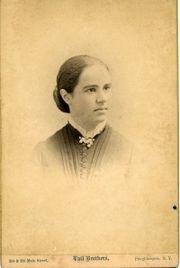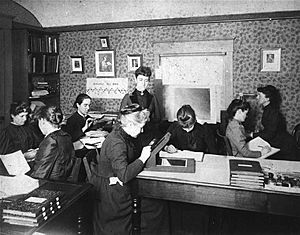Antonia Maury facts for kids
Quick facts for kids
Antonia Maury
|
|
|---|---|
 |
|
| Born | March 21, 1866 Cold Spring, New York
|
| Died | January 8, 1952 (aged 85) Dobbs Ferry, New York
|
| Nationality | American |
| Alma mater | Vassar College |
| Awards | Annie Jump Cannon Award in Astronomy (1943) |
| Scientific career | |
| Fields | Astronomy |
| Institutions | Harvard College Observatory |
| Academic advisors | Maria Mitchell |
Antonia Maury (born March 21, 1866 – died January 8, 1952) was an amazing American astronomer. She was the first person to find and figure out the path of a special type of double star called a spectroscopic binary.
Antonia Maury also created an important way to classify stars based on their light, which is called stellar spectra. Her system was so good that the International Astronomical Union later adopted it. She spent many years studying a specific double star called Beta Lyrae. Maury was part of the Harvard Computers, a group of talented women who worked at the Harvard College Observatory.
In 1943, Antonia Maury received the Annie Jump Cannon Award in Astronomy. A famous astronomer named William Wilson Morgan, who built on her work, said she was "the single greatest mind" in understanding star spectra.
Contents
Early Life and Family
Antonia Maury was born in Cold Spring, New York, in 1866. Her family had a strong connection to science. Her grandfather, John William Draper, and her uncle, Henry Draper, were both pioneering astronomers. Her aunt, Mary Anna Draper, even helped fund research at the Harvard College Observatory.
Because of her family, Antonia and her two siblings learned about science from a young age. Her younger sister, Carlotta Maury, became a well-known geologist and paleontologist.
Antonia Maury went to Vassar College and graduated in 1887 with top honors. She studied physics, astronomy, and philosophy. At Vassar, she learned from the famous astronomer Maria Mitchell.
Working with Stars
After college, Maury started working at the Harvard College Observatory. She was one of the "Harvard Computers," a group of skilled women who helped analyze huge amounts of astronomical data. However, she was paid much less than men for the same work.
Discovering Double Stars
In 1887, another astronomer, Edward Charles Pickering, found the first spectroscopic binary star, Mizar A. Maury was asked to figure out its orbit. She did this by looking at how the light from the star changed.
Then, in 1889, Maury discovered a second spectroscopic binary star, Beta Aurigae. She also calculated how long it took for these two stars to orbit each other. A very important astronomer, John Herschel, was impressed by her work. He wrote to Pickering, the observatory's director, to congratulate Miss Maury.
However, when these discoveries were announced, Pickering often took most of the credit. Maury's name was sometimes only mentioned briefly, even though she did the detailed work.

Classifying Stars
In 1888, Maury was given the job of observing and cataloging the light patterns (spectra) of bright stars. Her work helped create the Henry Draper Catalogue, a huge collection of star data.
The observatory used a simple alphabetical system for classifying stars. But Maury found it wasn't detailed enough. So, she created her own system. Her system was much more advanced. It included information about a star's temperature and how clear or wide its spectral lines were.
In 1891, Maury left the observatory for a while to teach. Pickering asked her to come back to finish her star observations. Maury agreed, but she wanted her work to be properly recognized. She felt it was unfair if her detailed theories and observations weren't credited to her.
She returned in 1893 and 1895. In 1897, she published her important catalog of star classifications. It was called Spectra of Bright Stars Photographed With the 11-Inch Draper Telescope As Part of the Henry Draper Memorial and Discussed by Antonia C. Maury Under the Direction of Edward Charles Pickering. This was the first time a woman's name was in the title of an observatory publication.
Pickering and others at the observatory didn't agree with Maury's classification system at first. They didn't use it, which made her decide to leave the observatory again.
Maury's Work Gains Recognition
However, in 1908, a Danish astronomer named Ejnar Hertzsprung realized how valuable Maury's classifications were. He used her system to tell the difference between very bright red giant stars and fainter dwarf stars. Hertzsprung wrote to Pickering, saying that Maury's work was "the most important advancement in stellar classification" in a long time.
It wasn't until 1922 that the International Astronomical Union (IAU) changed its star classification system based on the work of Maury and Hertzsprung. This led to the famous Hertzsprung–Russell diagram, which helps astronomers understand stars. Some scientists believe that astronomy was held back for 30 years because Maury's ideas weren't adopted sooner.
Between 1896 and 1918, Maury taught physics and chemistry. She also gave astronomy lectures at Cornell University.
In 1918, Maury returned to Harvard College Observatory. This time, her work was published under her own name. She stayed there until she retired in 1948. In 1933, she published her many years of research on the binary star Beta Lyrae.
Awards and Legacy
Antonia Maury was a member of important groups like the American Astronomical Society and the Royal Astronomical Society.
In 1943, she received the Annie Jump Cannon Award in Astronomy from the American Astronomical Society.
A crater on the Moon is named Maury in her honor. It's also named after her cousin, Commander Matthew Fontaine Maury.
In 1978, a book about star classification honored Antonia C. Maury as the "Master Morphologist of Stellar Spectra."
Later Years
After retiring, Maury spent time on her other interests, like nature and conservation. She loved birdwatching and was part of the National Audubon Society. She also worked to protect giant Sequoia trees.
For three years, Maury was the curator of the John William Draper House in Hastings-on-Hudson, New York. This was where her grandfather and uncle had built their observatories. It was also where the first photos of the Moon through a telescope were taken!
Antonia Maury passed away on January 8, 1952, in Dobbs Ferry, New York.
See Also
 In Spanish: Antonia Maury para niños
In Spanish: Antonia Maury para niños


